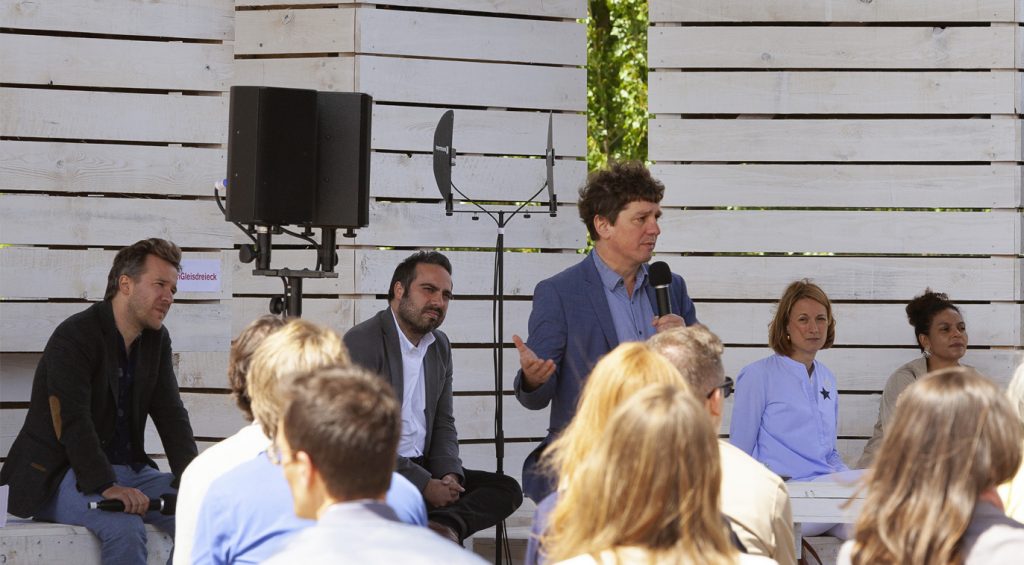CONVERSATIONS ABOUT THE CITY OF THE PRESENT
CHANCE, STONE AND HYPERLOOPS
The closing event of the MakeCity festival, a festival all about architecture and doing things differently, brought together inspiring speakers for a Sunday discussion at Urbane Mitte At Gleisdreieck: How do materials and constructions, mobility, and movement – but also the power of chance – shape Berlin?
Berlin, 5th July 2018 – How can we think, build and shape cities differently – beyond far-distant future scenarios? This was what inspired the team behind Urbane Mitte At Gleisdreieck, COPRO, architects O&O Baukunst, and the future B-Part Urban Ideation Lab to invite local Berliners to listen to unique insights from experts and thought leaders from the transport industry, the start-up scene, the city’s night-time economy, the art scene and the world of literature on 1st July. The key takeaway from the event: Berlin is Germany’s top driver of innovation, in terms of culture and urban development, mobility, and sustainable working environments. The emergence of innovation labs in the capital is intended to accelerate this development.
Short video “Chance, Stone and Hyperloops”. The video is only available in German.
Speakers at the event included Markus Penell, head of O&O Baukunst architects and Berlin-based artist Christian Awe. The former developed the master plan for the future Urbane Mitte At Gleisdreieck district together with the team from O&O Baukunst architects. Other guests included Dr Meike Niedbal, Head of Business Development at DB Station & Service and Smart Cities Project Lead; Jackie Thomae, journalist and best-selling author; Dimitri Hegemann, founder of notorious Tresor club; and Darius Moeini, co-founder of Numa Berlin, who together explored themes such as mobility, start-ups, art and culture, and Berlin’s nightlife. The panel was led by journalist and non-fiction author Dr Christian Ankowitsch.

B-Part: The Urban Ideation Lab to shape the living and working environments of tomorrow
Ansgar Oberholz, founder of the internationally renowned coworking pioneer, St. Oberholz, started the event by announcing the launch of B-Part, an innovation lab for the ideal city quarter. At the site where the “Urbane Mitte Am Gleisdreieck”, one of the last inner-city building areas in Berlin, is to be closed in the future, a temporary building will be erected in modular wooden construction at the beginning of 2019: B-Part offers on approx. 1,000 square meters directly alongside the park an innovation space for people who want to experience, explore and shape the living and working environments of tomorrow. B-Part will offer around 100 spaces for flexible, healthy and inspiring work. It will be a fusion of creative workshop, experimental laboratory, and think tank.
The Urban Ideation Lab will provide a platform to generate and share knowledge and content from the most diverse ideas and individuals with everyone from industry to start-ups, freelancers, and people from the local area. “The aim is for it to act as a pioneer to spread the word about the development of Urbane Mitte At Gleisdreieck and explore concepts around human coexistence in the future,” explains Oberholz, who will support the project as an ambassador until its opening.
Urbane Mitte At Gleisdreieck: a city quarter of the future in the heart of Berlin
On the theme of ‘stone’, Markus Penell from O&O Baukunst then presented current thinking on architecture and urban development to the more than 150 visitors at the spot where the city quarter will be built. In his talk, Penell presented the urban development concept behind Urbane Mitte At Gleisdreieck. In the future, this is a place which will connect local craftsmanship and regional production with collaborative working environments and new approaches to mobility. The panel guests were able to get a feel for the buildings that will be erected on the site through miniature representations. A wooden model of the city quarter built to a 1:20 scale was created especially for the event and served as a stage for the conversations.
Cult nightclub Tresor: on the courage to explore the unfinished and accidental
Dimitri Hegemann spoke about the element of ‘chance’, and how he found the right location for what later became his renowned techno nightclub, Tresor, as the result of an unforeseen circumstance. With its unfinished and authentic charm, this ultimately became an important part of Berlin’s famous nightlife. When the fall of the Berlin wall caused the city to explode, bringing together young people from both East and West, many new spaces and creative ideas took shape. People celebrated this uncontrolled momentum and infused Berlin with new energy. The subculture that developed has since flowed into the creative industries. On this note, he pleaded for young people in particular to be provided with more space for experimentation in the city, in order to maintain this spirit over the years to come.
Mobility concepts: the city becomes a smart city
At the end of the event, Dr Meike Niedbal, Head of Business Development at DB Station & Service, spoke about ‘movement’, revealing how Deutsche Bahn acknowledges mobility as a key element of modern cities and the role people play in the design of smart and flexible mobility solutions. In her keynote speech, Smart Cities: Logistics, Mobility and Railway Stations, she shared new perspectives on inner-city transportation in its present and future incarnations.
Substance, mobility and serendipity – these driving forces will continue to form and shape Berlin in the future. At the Gleisdreieck, these are only three of several important topics with which urban development is examined, sharpened and ultimately realized in terms of its future viability. The creativity required for this is increasingly focused on innovation spaces such as B-Part, the future Urban Ideation Lab for all those who want to experience, explore and help shape the living and working environments of tomorrow.
Categories
The Gleisdreieck has always been a place filled with movement. Ideas now circulate in a location where goods were once moved around.
PROF. MANFRED ORTNER, ARCHITECTURE FIRM ORTNER & ORTNER BAUKUNST

